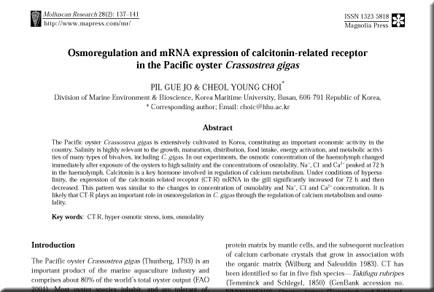Abstract
The Pacific oyster Crassostrea gigas is extensively cultivated in Korea, constituting an important economic activity in the country. Salinity is highly relevant to the growth, maturation, distribution, food intake, energy activation, and metabolic activities of many types of bivalves, including C. gigas. In our experiments, the osmotic concentration of the haemolymph changed immediately after exposure of the oysters to high salinity and the concentrations of osmolality, Na+, Cl- and Ca2+ peaked at 72 h in the haemolymph. Calcitonin is a key hormone involved in regulation of calcium metabolism. Under conditions of hypersalinity, the expression of the calcitonin-related receptor (CT-R) mRNA in the gill significantly increased for 72 h and then decreased. This pattern was similar to the changes in concentration of osmolality and Na+, Cl- and Ca2+ concentration. It is likely that CT-R plays an important role in osmoregulation in C. gigas through the regulation of calcium metabolism and osmolality.

